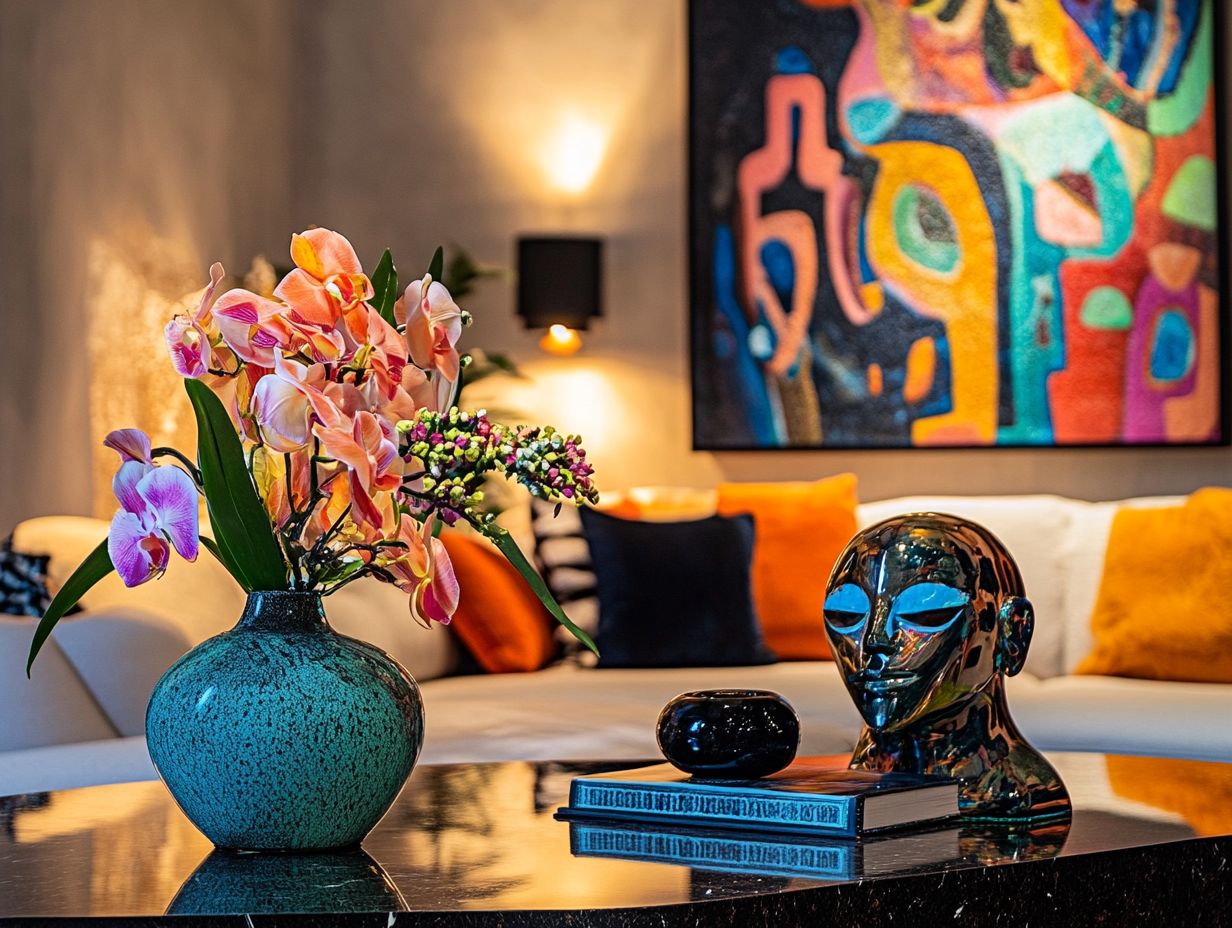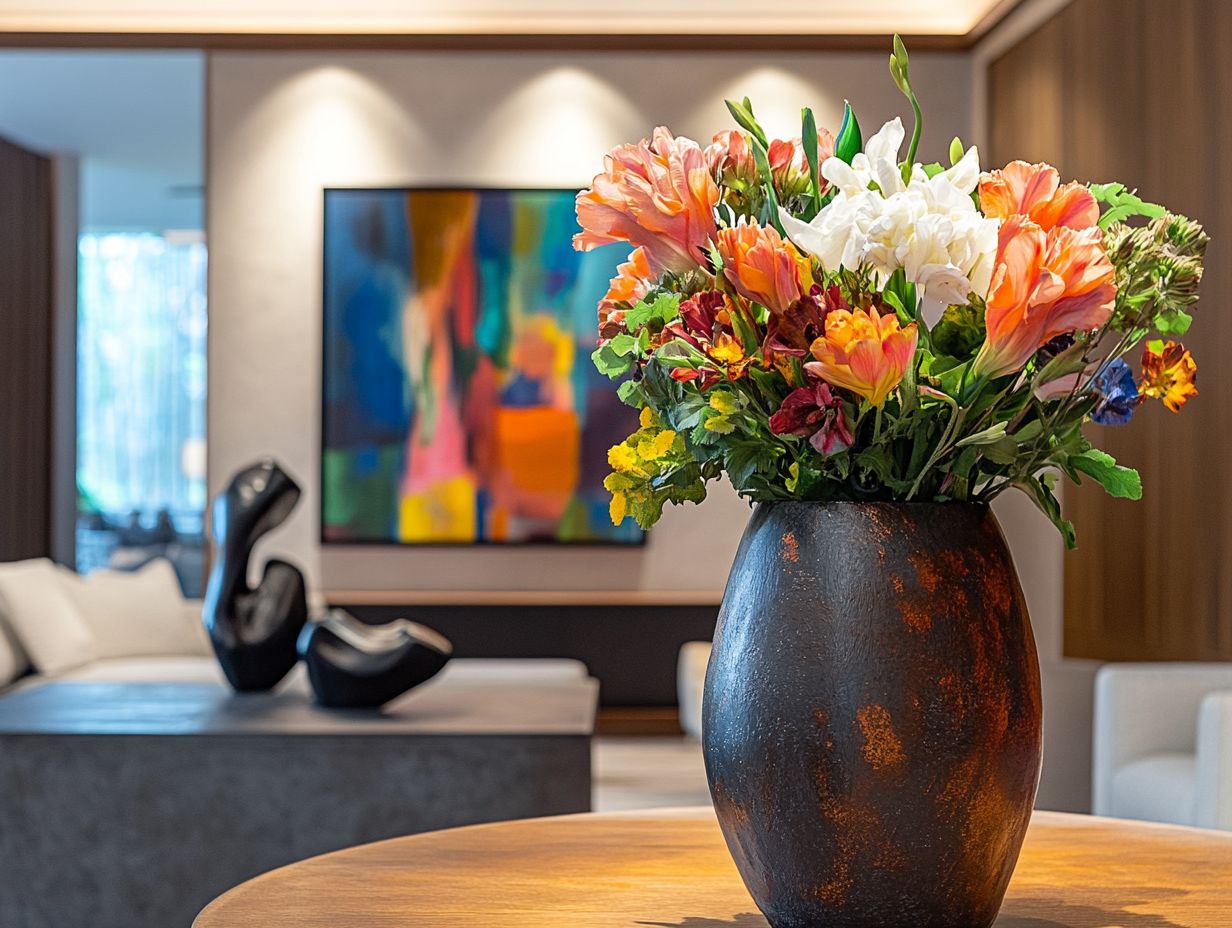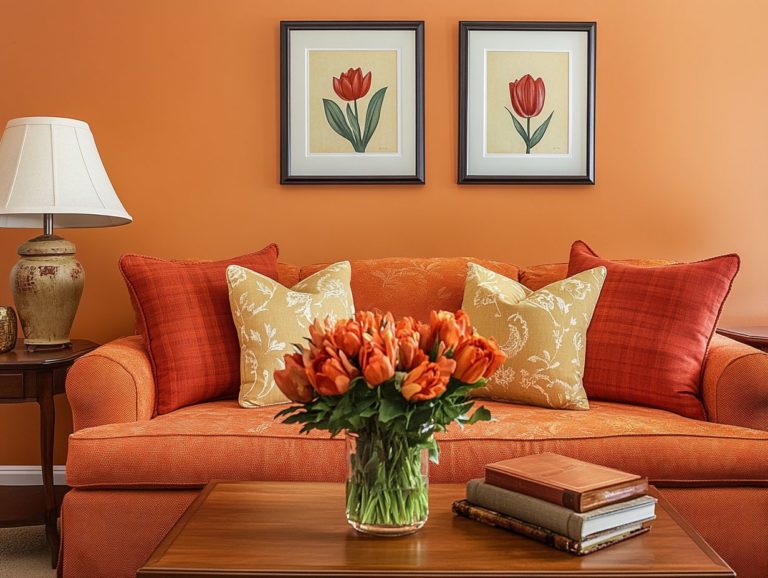Understanding the Value of Decorative Items
Decorative items are essential in shaping the aesthetics and ambiance of your living spaces. They elevate visual appeal, express your personal style, and cultivate a welcoming atmosphere.
This article delves into an array of decorative items, ranging from functional pieces to purely aesthetic accents. It guides you on how to choose the right elements for your home. It also offers insightful DIY ideas and tips for seamlessly integrating these touches into various rooms, ensuring your decor truly reflects your unique personality.
Contents
- Key Takeaways:
- The Role of Decorative Items in Interior Design
- Types of Decorative Items
- Popular Materials and Styles
- Factors to Consider When Choosing Decorative Items
- DIY Decorative Ideas
- Incorporating Decorative Items into Different Spaces
- Frequently Asked Questions
- What are decorative items and why are they valuable?
- How can decorative items add value to a home?
- What are some factors that contribute to the value of decorative items?
- How can I determine the value of a decorative item?
- Why should I invest in high-quality decorative items?
- Are decorative items strictly for aesthetics or can they serve a practical purpose?
Key Takeaways:

- Decorative items make your space inviting and personal.
- Consider functionality, materials, and style when choosing decorative items to ensure they match your existing decor.
- Incorporating DIY decorative ideas can add a unique touch, allowing for a more personalized and budget-friendly design.
The Role of Decorative Items in Interior Design
In the world of interior design, decorative items are essential for elevating the aesthetics and ambiance of any space. They craft an environment that feels both well put together and inviting.
Whether it’s a vintage find or a unique furniture piece, these elements express personal style while also embodying historical significance and beautiful design and skillful work.
Your thoughtful selection of decorative art can completely transform a room. It creates focal points that capture attention and evoke emotions. It s vital for both designers and homeowners to recognize the value and impact these pieces have on overall decor.
Enhancing Aesthetics and Atmosphere
Enhancing the aesthetics and atmosphere of your home involves carefully choosing decorative objects that reflect your personal style and harmonize with your overall design theme.
Objects like vintage decorative pieces and unique furniture can transform an ordinary space into one brimming with character and allure. For example, a beautifully restored mid-century coffee table serves as a practical item and a captivating conversation starter, showcasing your appreciation for timeless design.
Displaying a collection of antique vases on a floating shelf can infuse your room with a sense of history and personalization, elevating its visual appeal. Research shows that homeowners who thoughtfully integrate these distinctive items often create spaces that radiate warmth and sophistication, making their homes truly inviting for both family and guests.
Types of Decorative Items
Decorative items can be divided into two primary categories: functional and non-functional. Each type serves a distinct purpose in elevating interior spaces, while highlighting beautiful design and skillful work and aesthetic appeal.
Functional vs. Non-Functional
Functional items are those that you can use every day, like storage or lighting. Non-functional items, like sculptures or artwork, focus solely on aesthetic appeal.
By integrating both categories into your interior design, you can create spaces that are visually striking and cater to your everyday needs. Imagine a beautifully designed shelving unit that holds your cherished books and trinkets, providing necessary storage while also acting as a captivating focal point in the room. A vibrant piece of wall art can elevate the overall mood of your space, enriching your experience within it.
Striking the right balance between these elements is essential. Too many functional items can create a cluttered atmosphere, while an excess of decorative pieces might compromise practicality. By skillfully combining both types, you achieve a sense of harmony, making your spaces both inviting and functional, with each element contributing to a cohesive design narrative.
Popular Materials and Styles

The materials and styles you choose significantly define the character of your decorative items. Options like wood, metal, and antique textiles beautifully enhance both vintage and contemporary looks.
These materials add authenticity and reveal the careful details behind different design styles. For instance, the rich patina of aged wood connects you to history, while the shiny surfaces of metals like brass and copper bring a modern flair. Antique textiles, often woven with great detail, not only serve practical purposes but also spark conversations about the artisans of the past.
By combining these elements, you develop an appreciation for decorative arts and their lasting influence on classic styles like antique and vintage furniture.
Factors to Consider When Choosing Decorative Items
When selecting decorative items, evaluate several key factors. Think about how each piece fits with your current decor and the overall aesthetic of your space.
Consider the value of your existing furniture, as well as the condition and rarity of potential new additions. These aspects can significantly affect market demand and enhance your collection’s appeal.
Matching with Existing Decor
To match decorative items with your existing decor, pay attention to color schemes, styles, and materials for a cohesive look throughout your space.
Start by assessing the overall palette of your rooms, noting both bold hues and subtle tones that unify various elements. Incorporating vintage items can add character, but ensure they complement your existing furniture.
Strategically place a decorative vase or striking artwork to elevate the ambiance, reflecting the prevalent style whether modern, rustic, or eclectic.
Balancing textures is also essential. Mixing sleek glass with distressed wood can add depth while maintaining a visually appealing flow, promoting the coordinated aesthetic you aim for.
Budget and Maintenance
Establishing a budget and considering maintenance requirements are vital when choosing decorative items. Both can greatly influence your long-term satisfaction and the investment value of your choices.
As you explore options, assess furniture prices alongside the quality of available restoration options. A well-planned budget allows you to pick items that align with your financial goals while promising durability and aesthetic appeal.
Understanding the maintenance needs of your chosen pieces is crucial for their longevity and overall look. When necessary, investing in high-quality restoration services enhances the attraction and functionality of your decorative items, safeguarding your investment for the future.
DIY Decorative Ideas
Exploring DIY decorative ideas gives you the power to craft unique furniture pieces and decorative items that truly reflect your personality. This approach keeps your budget intact while showcasing your resourcefulness.
Creative and Budget-Friendly Options

Creative and budget-friendly options for DIY decorative items abound, inviting you to explore the art of upcycling vintage treasures, utilizing affordable materials, and experimenting with restoration techniques.
These methods allow you to turn ordinary objects into extraordinary decor. For example, transform old glass jars into stunning candle holders that add flair to any room. With techniques like decoupage, where you glue paper cutouts onto an object for decoration, you can breathe new life into tired furniture. Imagine revitalizing an old chair with vibrant fabric scraps that speak to your style.
Incorporating natural elements, such as twigs or pinecones, enhances the aesthetic of your projects while keeping costs down. Explore different paints, stains, and adhesives to create unique decorations that truly reflect your personal flair.
Incorporating Decorative Items into Different Spaces
When adding decorative items, think carefully about your room’s style and furniture. This detail helps create a cohesive look throughout your home.
Smart Styling Tips for Every Room!
When incorporating decorative items into various rooms, consider effective strategies such as selecting the right styles, balancing functionality with aesthetics, and acknowledging the unique characteristics of each space.
For your living room, designed for relaxation, choose soft, inviting textures like plush throw pillows and warm, ambient lighting that beckons comfort. In your bedroom, aim for tranquility and personalization. Decorative items such as artful bedside lamps or serene wall art are essential for creating a peaceful atmosphere.
In workspaces, remember that functionality reigns supreme. Integrating stylish yet practical organizers can elevate the look without sacrificing utility.
By understanding the essence of each room, you can achieve a seamless blend of decor that enhances both visual appeal and overall ambiance.
Frequently Asked Questions
What are decorative items and why are they valuable?
Decorative items are things like paintings, vases, or candles that make your space look great. They hold value because they add character and personality to a room, making it more visually appealing and comfortable.
How can decorative items add value to a home?

Decorative items can add value to a home by making it more attractive to potential buyers. A well-decorated home creates a welcoming and cozy atmosphere, making it more appealing for people to live in and potentially increasing its overall value.
What are some factors that contribute to the value of decorative items?
The value of decorative items can be influenced by factors such as rarity, age, quality of craftsmanship, and cultural or historical significance. These factors can make an item more desirable and valuable to collectors or buyers.
How can I determine the value of a decorative item?
The value of a decorative item can vary greatly and can be subjective. Some ways to determine its value include researching its history and origins, consulting with experts or appraisers, and considering current market trends and demand for similar items.
Why should I invest in high-quality decorative items?
Investing in high-quality decorative items can be a sound decision, as these items tend to hold their value and can even appreciate over time. They also add a touch of luxury and sophistication to a space, making it a worthwhile investment for those who appreciate fine craftsmanship and unique design.
Are decorative items strictly for aesthetics or can they serve a practical purpose?
Decorative items serve both aesthetic and practical purposes! A decorative bowl can hold items or act as a centerpiece.
Mirrors are another great example. They help check your appearance and enhance the room’s visual appeal.






